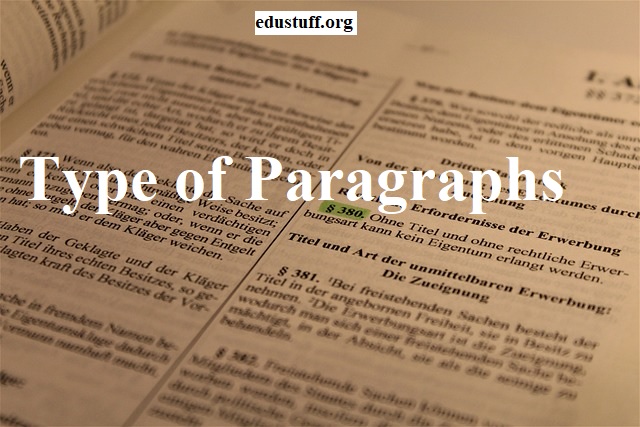
Type of paragraphs: Write Like a Pro.
Type of paragraphs: Write Like a Pro.
In the vast landscape of written communication, paragraphs stand as the building blocks of our thoughts and ideas. They are the distinct sections that structure our narratives, arguments, and explanations. Yet, many readers might overlook the intricate artistry involved in crafting these textual units. In this exploration, we will delve into the world of paragraphs, understanding their essence, unravelling their significance, and dissecting the diverse types that lend depth and dimension to our written expression.
You may love to read:
What must food handlers do before taking out the garbage
What is a paragraph?
A paragraph is the elemental construct of written communication, a fundamental unit that segregates ideas and offers readers a brief respite. It’s akin to a finely crafted brick in a grand architectural masterpiece, an indispensable element without which the entire structure would crumble. In its most essential form, a paragraph is a coherent group of sentences that revolves around a central idea or theme. It serves as the anchor, the gravitational centre, around which your words orbit.
Why are paragraphs important?
Imagine a world without paragraphs—an endless stream of words, a narrative with no breaks or pauses. Such a world would be chaotic, confusing, and overwhelming. Paragraphs are the architects of structure in the sprawling cityscape of your text. They are the road signs, directing readers, ensuring they don’t get lost in the labyrinth of your thoughts. Without paragraphs, your message loses its clarity, and your readers lose their way.
Different types of paragraphs
Just as an artist employs various brush strokes to create a masterpiece, writers employ different types of paragraphs to convey their messages with precision and impact. Each type serves a unique purpose, and mastering them expands your writing repertoire. Let’s dive into this ocean of diversity.
Descriptive Paragraph: Painting with Words
In the realm of paragraphs, the descriptive type is the virtuoso of vivid imagery. Its purpose is to transcend the mundane and transport readers to another realm, be it a serene mountain vista, a bustling cityscape, or the depths of an enchanted forest. With a palette of specific language and sensory details, it paints a vivid, almost tangible, picture in the reader’s mind.
Within a descriptive paragraph, words become strokes of a painter’s brush, crafting a masterpiece of sensory experiences. For instance, instead of merely stating that a garden is beautiful, a descriptive paragraph weaves a tapestry of details—vibrant blossoms swaying in the breeze, the heady scent of earth, and the gentle hum of bees—all to immerse the reader in the garden’s enchantment.
Narrative Paragraph: The Art of Storytelling
Stories are the lifeblood of human communication, and narrative paragraphs are their chosen vessels. These paragraphs whisk readers away on adventures, tugging at heartstrings and sparking imagination. With a beginning, middle, and end, they are the storyteller’s canvas, adorned with vibrant language to captivate the reader.
In a narrative paragraph, the writer dons the role of a master storyteller, guiding the reader through a plot replete with characters, conflicts, and resolutions. With every sentence, they craft a compelling tale that leaves readers eagerly turning the page, hungry for more.
Expository Paragraph: The Beacon of Information
When the need for clarity arises, the expository paragraph shines like a beacon in the fog. Its mission: is to explain complex topics with the clarity of a lighthouse cutting through the night. Armed with facts and a concise narrative, it serves as an educational tool, demystifying intricate subjects.
Within an expository paragraph, precision is paramount. It strips away ambiguity and delivers information with surgical precision. Whether explaining the intricacies of a scientific theory or detailing the steps of a cooking recipe, the expository paragraph guides the reader through a labyrinth of facts with utmost clarity.
Persuasive Paragraph: The Art of Conviction
Persuasive paragraphs are the legal counsel of the writing world. They present evidence, arguments, and rationale to convince the reader of a particular viewpoint. Logic and reason are their allies, and their purpose is to sway opinion in their favour.
In the realm of persuasion, every word is a chess piece, and every sentence is a strategic move. Persuasive paragraphs construct a compelling case, appealing to both the reader’s intellect and emotions. They lay down a carefully structured argument, building a fortress of conviction that’s difficult to breach.
Argumentative Paragraph: Taking a Stand
While similar to persuasive paragraphs, argumentative paragraphs boldly take a stance on a contentious issue. They serve as the warrior’s cry in the battleground of ideas. With unyielding evidence and a formidable arsenal of logic, they defend their position and challenge opposing viewpoints.
Argumentative paragraphs are the clash of titans, where ideas spar with intellectual rigour. They engage in intellectual duels, wielding the sword of reason and the shield of evidence. These paragraphs are where opinions clash and evolve, shaping the discourse of society.
Illustration Paragraph: Painting with Examples
Sometimes, a single example can illuminate a complex concept. Enter the illustration paragraph, which deploys specific instances to underscore a point. These paragraphs are the architects of clarity, building comprehension brick by brick.
In the hands of a skilled writer, an illustration paragraph is akin to an artist’s sketchbook, filled with vivid examples that breathe life into abstract ideas. They bridge the gap between the conceptual and the tangible, helping readers grasp complex concepts with ease.
Process Paragraph: The Blueprint of Action
Ever wondered how to bake the perfect soufflé or assemble a piece of furniture from a baffling set of instructions? The process paragraph holds the answers. It’s a step-by-step guide, meticulously detailing how to accomplish a task, leaving no room for confusion.
Within the confines of a process paragraph, precision reigns supreme. Every action, every nuance, is articulated with painstaking detail. It transforms the abstract into the actionable, ensuring that readers can follow instructions effortlessly, be it in the kitchen, the workshop, or any other endeavour.
Definition Paragraph: The Clarity Crusader
In the labyrinth of language, clarity is the guiding star, and definition paragraphs are its champions. They succinctly define terms or concepts, offering a clear and concise understanding. Occasionally, they may sprinkle in examples or synonyms to further illuminate the subject.
Definition paragraphs are like linguistic lighthouses, cutting through the fog of ambiguity to reveal the essence of a term or concept. They are a beacon of clarity in the often murky waters of language, ensuring that readers have a firm grasp of the subject at hand.
Comparison and Contrast Paragraphs: Balancing Act
In the world of juxtaposition, comparison and contrast paragraphs stand tall. They analyze the similarities and differences between two or more entities, helping readers draw connections and distinctions with ease.
These paragraphs are the architects of perspective, inviting readers to view the subject from multiple angles. They unveil the hidden nuances, allowing readers to appreciate both the commonalities and disparities between the compared elements.
Conclusion
In this exploration of the multifaceted world of paragraphs, we have uncovered their profound importance and the distinct roles they play in written expression. Each type of paragraph serves as a unique tool in a writer’s arsenal, allowing for the effective conveyance of ideas, stories, information, and persuasion.
From the vivid imagery of descriptive paragraphs to the logical precision of expository paragraphs, and from the persuasive prowess of argumentative paragraphs to the clarity of definition paragraphs, these textual components enrich our writing, making it engaging, informative, and convincing






